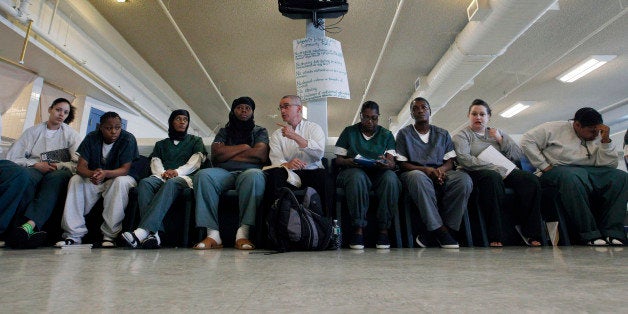
Shows like "Orange Is the New Black" (OITNB) and investigative documentaries like Diane Sawyer's "A Nation of Women Behind Bars" highlight life in lockdown and have opened up a national conversation about the lives and treatment of female prisoners.
Reality vs. TV
When it comes to portraying women in prison, television either heightens the reality as seen in "OITNB" and Australia's dark drama "Wentworth," or takes us behind the concrete walls and barbed-wire fences to see the real faces of female prisoners in America. Both approaches serve a purpose, which is to humanize incarcerated women and help us understand how these women are more than criminals -- they are mothers, daughters, sisters, wives and best friends.
In the alternate reality of Danbury Prison, where "OITNB" takes place, life behind bars is often portrayed as a strict summer camp where friendships are made, alliances are formed, and sing-alongs and dance parties help break up the monotony. Other times we are led down the darker corridors of prison life: assault, abuse of power, paralyzing fear and desperate loneliness.
"In a nation whose justice system often offers little more than one-size-fits-all injustice, a television series that inspires viewers to see convicts as fellow human beings can help us better understand and perhaps have a bit more empathy toward them," The Washington Post reported. "We should not confuse a TV program with a criminology course, but 'Orange is the New Black' goes a long way toward narrowing the gap between our perceptions of convicts and the sometimes surprising reality."
The groundbreaking show, based on the real experiences of Piper Kerman, garnered both praise and criticism. Praise for making the reality of women behind bars a national conversation, and criticism for glamorizing or sugar-coating the experiences from which other former prisoners are still trying to recover.
One real inmate from Danbury wrote, "The Netflix series 'Orange is the New Black' isn't funny to the women who served time in Danbury Federal Prison. I know because I am one of those women."
Balancing the public perception is a selection of reality docu-series that take a long, hard look at real women serving out real sentences in real time. TLC aired several specials that explore different issues faced by female prisoners. "Babies Behind Bars" looked at prisoners taking childcare classes in preparation to one day take care of the children they gave birth to in prison.
"Breaking Down the Bars" is a series helmed by Oprah's OWN network and, in addition to daily prison life, this show focuses on therapy and rehabilitation. Producers even brought their own clinical psychologist to work with inmates.
Most recently, FOX's hit "Empire" has joined the ranks of shows portraying the impact of prison on American women. The show's matriarch, Cookie (Taraji P. Henson) may be the powerhouse that brought her family to fame and fortune, but that luxury was hard-won on the back of her time in prison.
"While many may be wrapped up in the cosmic mix of glamour and OG attitude that is Cookie, her background provides the character with a depth and complexity that still lacks from portrayals of black women on TV," according to the analysis of Henson's character done by For Harriet. "Cookie represents the substantial number of black mothers who are separated from their children while serving prison sentences."
Hope for the Hopeless
Cookie's character highlights the impact of incarceration on mothers and the children they must leave behind while incarcerated--an issue that is reaching epidemic proportions. Not only does America currently have over 200,000 women serving sentences, but it is the largest female prisoner population on earth. Of those, approximately 56 percent report being parents. There are also two African-American women behind bars for every white female inmate.
"There are now 200,000 women in prison or jail in the United States, a figure that represents an increase of over 750% in the last three decades, and nearly twice the rate of increase that men experienced," according to the Women's Prison Association. "As is the case with men, incarceration rates for women also reflect tremendous racial disparities; one out of every 100 black women in the U.S. is now incarcerated, nearly three times the rate for women overall."
Not only do shows like "OITNB" and "Empire" make female prisoners real to us, but they also highlight the additional societal issues that contribute to the epidemic of women behind bars in America. Economic status, race, and education remain factors for criminal activity and subsequent incarceration. In an age when we often congratulate ourselves on how far we've come, it's important to be reminded that our enlightenment as a nation has not yet come to fruition.
Both the numbers and the images of women behind bars can feel overwhelming and discouraging. However, the impact of media and audience interest in the plight of female prisoners is shedding a light on issues that may not otherwise be addressed.
While there are certainly creative liberties taken in "OITNB," several real issues have been explored--from the perpetuation of guards using their power and influence to trade favors for sex to the rights of transgender inmates to receive prescribed hormone therapy while incarcerated.
The more we are exposed to the realities of life for female prisoners, the more we will be mobilized to work for fair treatment, reasonable sentencing, and support for both prisoners and their families. If you've been inspired to make a difference for women prisoners there are a variety of ways to become involved, including work with at-risk girls and women who may be able to avoid a life behind bars.
Working as a tutor or mentor with at-risk girls or young women who have just become involved in the court system can help make an impact before it's too late. Check with state organizations to find out how you can become involved in building self-esteem, cultivating social skills and improving educational performance. The Women's Prison Association also offers a multitude of volunteer options that range from community involvement to active work with female prisoners and parolees.
Thanks to recent television exposure, the national conversation about women in prison is louder and more active than ever before. While America is undeniably facing a challenge when it comes to the proliferation of female prisoners, there is hope that we will mobilize as a nation to curb the tide. Television may not be the answer, but it is certainly a catalyst for awareness, activism, and change.
